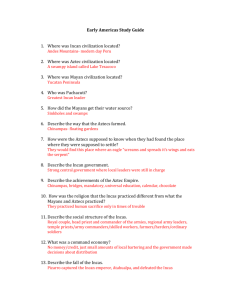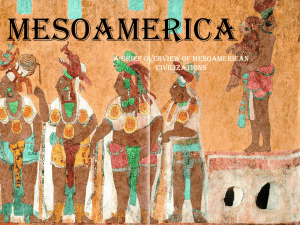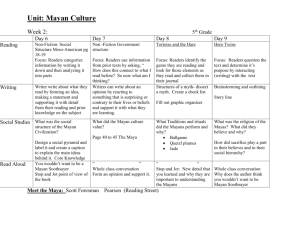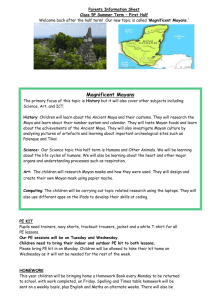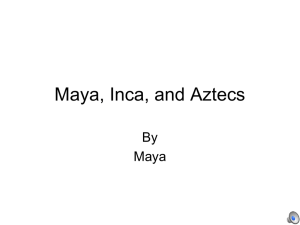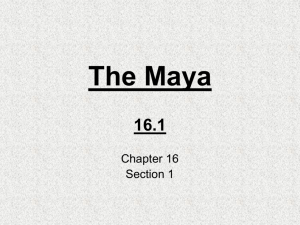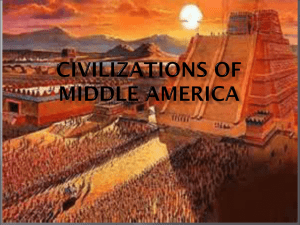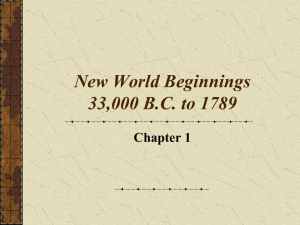WEBQUEST PROJECT: Ancient Civilizations of the
advertisement
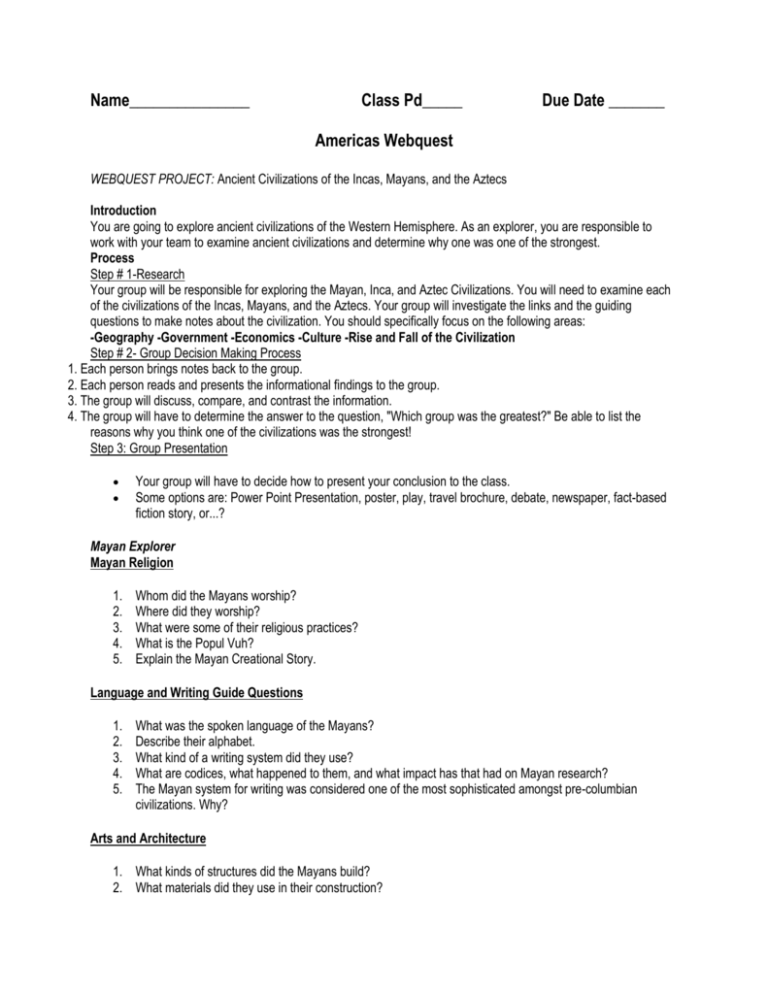
Name_______________ Class Pd_____ Due Date _______ Americas Webquest WEBQUEST PROJECT: Ancient Civilizations of the Incas, Mayans, and the Aztecs Introduction You are going to explore ancient civilizations of the Western Hemisphere. As an explorer, you are responsible to work with your team to examine ancient civilizations and determine why one was one of the strongest. Process Step # 1-Research Your group will be responsible for exploring the Mayan, Inca, and Aztec Civilizations. You will need to examine each of the civilizations of the Incas, Mayans, and the Aztecs. Your group will investigate the links and the guiding questions to make notes about the civilization. You should specifically focus on the following areas: -Geography -Government -Economics -Culture -Rise and Fall of the Civilization Step # 2- Group Decision Making Process 1. Each person brings notes back to the group. 2. Each person reads and presents the informational findings to the group. 3. The group will discuss, compare, and contrast the information. 4. The group will have to determine the answer to the question, "Which group was the greatest?" Be able to list the reasons why you think one of the civilizations was the strongest! Step 3: Group Presentation Your group will have to decide how to present your conclusion to the class. Some options are: Power Point Presentation, poster, play, travel brochure, debate, newspaper, fact-based fiction story, or...? Mayan Explorer Mayan Religion 1. 2. 3. 4. 5. Whom did the Mayans worship? Where did they worship? What were some of their religious practices? What is the Popul Vuh? Explain the Mayan Creational Story. Language and Writing Guide Questions 1. 2. 3. 4. 5. What was the spoken language of the Mayans? Describe their alphabet. What kind of a writing system did they use? What are codices, what happened to them, and what impact has that had on Mayan research? The Mayan system for writing was considered one of the most sophisticated amongst pre-columbian civilizations. Why? Arts and Architecture 1. What kinds of structures did the Mayans build? 2. What materials did they use in their construction? 3. Who or what were the subjects of Mayan artwork? 4. Who were the artists? 5. What forms of artwork did the Mayans produce? Math and Science 1. 2. 3. 4. 5. 6. 7. 8. 9. How many symbols are used in the Mayan system of counting? What does each symbol represent? What did the Mayans use to expand this system to express very large values? How are the place values arranged? What is a “vigesimal” system and how does it differ from the system we use? What kind of devices did the Mayans use to make their astronomical observations? How did the enactment of rituals correlate with the collection of astronomical data? Describe the three kinds of calendars the Mayans used. Give some examples of structures that depict Mayan preciseness in calculations and astronomical observations. 10. What were other facets of Mayan life that depended on the astronomical data collected? Location and Agriculture 1. Locate a map that highlights the areas the Mayans inhabited. What countries today occupy former Mayan territories? 2. Which crop was the most important to Mayan society? 3. What are some other crops that the Mayans raised? 4. How did they irrigate crops and clear fields? 5. What do we enjoy today as a sweet treat thanks to the Mayans? How did they enjoy it? Government and Society 1. 2. 3. 4. 5. Describe the housing and layout of the “kingdoms” of Mayan people. What were the roles of men and women? Who were the leaders and what were their privileges? How were the Mayan “kingdoms” governed? Who was Lord Pascal? Fall of the Mayan Civilization 1. Who was responsible for the fall of the Mayan Civilization? 2. What happened to the Mayans? 3. Why did the Mayan Civilization fall? Mayan Links: http://www.lost-civilizations.net/mayan-religion-popol-vuh.html Religion http://www.indians.org/welker/maya.htm http://www.wsu.edu:8080/~dee/CIVAMRCA/MAYAS.HTM http://www.students.dsu.edu/rummelf/mayan.htm http://www.angelfire.com/ca/humanorigins/government.html#maya http://www.spanishome.com/activities/mayas/agriculture.htm Agriculture http://library.thinkquest.org/10098/mayan.htm Mayan Architecture http://www.hanksville.org/yucatan/mayamath.html Mayan Math http://www.crystalinks.com/aztecs.html Map that shows Mayan and Aztec concentrations http://www.crystalinks.com/mayan.html Mayans http://www.civilization.ca/civil/maya/mmc12eng.html http://www.civilization.ca/civil/maya/mmc04eng.html http://www.angelfire.com/ca/humanorigins/ Writing system http://www.michielb.nl/maya/astro.html Mayan astronomy, calendar, http://www.kstrom.net/isk/maya/mayamap.html Map of Mayan territories http://library.thinkquest.org/11577/art.htm Art samples http://www.crystalinks.com/mayanarch.html Mayan Art and Architecture http://www.leffingwell.com/h&rflavor/Chocolate%20%96%20Food%20of%20the%20gods.pdf Chocolate http://www.pbs.org/wgbh/nova/maya/world.html Maps and Archeological Info http://www.mayacalendar.com/f-mayamath.html Mayan Math http://mathforum.org/k12/mayan.math/ Mayan Math http://www.mexconnect.com/mex_/travel/ldumois/maya/ldmayacity.html Incan Civilization Incan Origins: 1. Who led the expansion of the Incan Empire? 2. How did the empire expand? 3. Where did the Inca live? Government: 1. Who ruled the Incas? 2. Describe the laws of the Incas. 3. How were criminals punished? 4. How were taxes paid? 5. Who received tax payments? Culture and Society: 1. Describe Incan clothing. 2. How did the Incas make their clothes? 3. What were the primary professions? 4. What were the roles of men and women? 5. What was the purpose of terraces? Language: 1. What was the language spoken by the Incas? 2. How were records kept? 3. How did messengers deliver messages? Incan Downfall: 1. What happened to the Incas? 2. Who was responsible for Incan downfall? 3. Why did the Incan Civilization fall? Incan Links: http://www.kathimitchell.com/mesoamericans.htm http://www.wsu.edu:8080/~dee/CIVAMRCA/INCAS.HTM http://www.internet-at-work.com/hos_mcgrane/inca/eg_inca_menu1.html http://www.nationalgeographic.com/inca Aztec Explorer Aztec Civilization Aztec Origins 1. Who led the expansion of the Aztec Empire? 2. How did the empire expand? 3. Where did the Aztecs live? Government 1. Who ruled the Aztecs? 2. Describe the laws of the Aztecs. 3. How were criminals punished? Culture and Society 1. 2. 3. 4. 5. 6. 7. 8. 9. Describe Aztec clothing. How did the Aztecs make their clothes? What were the primary professions? What were the roles of men and women? What was the role of their sport in their culture? Describe the Aztec calendar and its significance. Describe the significant art contributions of the Aztecs. What were the major architectural contributions of the Aztecs? Describe the class system found in the Aztec society. Language 1. What was the language spoken by the Aztecs? 2. Describe the written language of the Aztecs. Aztec Downfall 1. What happened to the Aztecs? 2. Who was responsible for Aztec downfall? 3. Why did the Aztec Civilization fall? Aztec Links: http://www.crystalinks.com/aztecs.html http://library.thinkquest.org/27981/ http://home.freeuk.net/elloughton13/aztecs.htm http://www.wsu.edu:8080/~dee/CIVAMRCA/AZTECS.HTM Conclusion Congratulations! You and your team have successfully researched ancient civilizations. You discovered what made the Mayan, Incan and the Aztecs successful as well as what caused them to fall. You discovered the ways of their society and their contributions to civilizations today. Rubrics. CATEGORY 4 3 2 1 Working with Others Almost always listens to, shares with, and supports the efforts of others. Tries to keep people working well together. Usually listens to, shares, with, and supports the efforts of others. Does not cause "waves" in the group. Often listens to, shares with, and supports the efforts of others, but sometimes is not a good team member. Rarely listens to, shares with, and supports the efforts of others. Often is not a good team player. Contributions Routinely provides useful ideas when participating in the group and in classroom discussion. A definite leader who contributes a lot of effort. Usually provides useful ideas when participating in the group and in classroom discussion. A strong group member who tries hard! Sometimes provides useful ideas when participating in the group and in classroom discussion. A satisfactory group member who does what is required. Rarely provides useful ideas when participating in the group and in classroom discussion. May refuse to participate. Time-management Routinely uses time well throughout the project to ensure things get done on time. Group does not have to adjust deadlines or work responsibilities because of this person's procrastination. Usually uses time well throughout the project, but may have procrastinated on one thing. Group does not have to adjust deadlines or work responsibilities because of this person's procrastination. Tends to procrastinate, but always gets things done by the deadlines. Group does not have to adjust deadlines or work responsibilities because of this person's procrastination. Rarely gets things done by the deadlines AND group has to adjust deadlines or work responsibilities because of this person's inadequate time management. Attitude Never is publicly critical of the project or the work of others. Always has a positive attitude about the task(s). Rarely is publicly critical of the project or the work of others. Often has a positive attitude about the task(s). Occasionally is publicly critical of the project or the work of other members of the group. Usually has a positive attitude about the task(s). Often is publicly critical of the project or the work of other members of the group. Often has a negative attitude about the task(s). Focus on the task Consistently stays focused on the task and what needs to be done. Very selfdirected. Focuses on the task and what needs to be done most of the time. Other group members can count on this person. Focuses on the task and what needs to be done some of the time. Other group members must sometimes nag, Rarely focuses on the task and what needs to be done. Lets others do the work. prod, and remind to keep this person ontask. Preparedness Brings needed materials to class and is always ready to work. Almost always brings needed materials to class and is ready to work. Pride Work reflects this student's best efforts. Work reflects a Work reflects some strong effort from this effort from this student. student. Work reflects very little effort on the part of this student. 4 3 2 1 Content Covers topic in-depth with details and examples. Subject knowledge is excellent. Includes essential knowledge about the topic. Subject knowledge appears to be good. Includes essential Content is minimal information about the OR there are several topic but there are 1- factual errors. 2 factual errors. Organization Content is well organized using headings or bulleted lists to group related material. Uses headings or bulleted lists to organize, but the overall organization of topics appears flawed. Content is logically organized for the most part. There was no clear or logical organizational structure, just lots of facts. Attractiveness Makes excellent use of font, color, graphics, effects, etc. to enhance the presentation. Makes good use of font, color, graphics, effects, etc. to enhance to presentation. Makes use of font, color, graphics, effects, etc. but occasionally these detract from the presentation content. Use of font, color, graphics, effects etc. but these often distract from the presenation content. CATEGORY Almost always brings Often forgets needed needed materials but materials or is rarely sometimes needs to ready to get to work. settle down and get to work Originality Product shows a large amount of original thought. Ideas are creative and inventive. Product shows some original thought. Work shows new ideas and insights. Uses other people's Uses other people's ideas (giving them ideas, but does not credit), but there is give them credit. little evidence of original thinking. Mechanics No misspellings or grammatical errors. Three or fewer misspellings and/or mechanical errors. Four misspellings and/or grammatical errors. More than 4 errors in spelling or grammar. Requirements All requirements are All requirements are One requirement met and exceeded. met. was not completely met. More than one requirement was not completely met.
